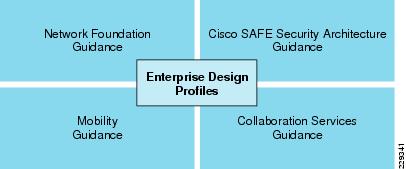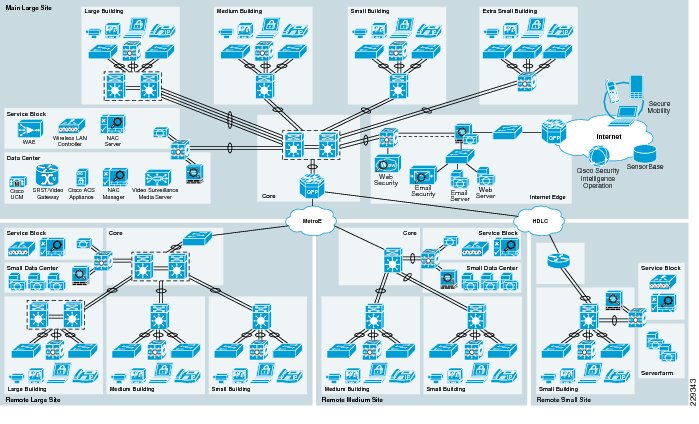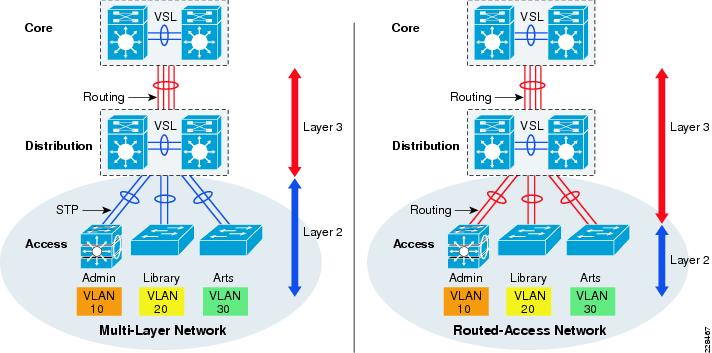

-
Medium Enterprise Design Profile Reference Guide
-
Medium Enterprise Design Profile(MEDP)—Service Fabric Design Considerations
-
Medium Enterprise Design Profile (MEDP)—LAN Design
-
Medium Enterprise Design Profile (MEDP)—WAN Design
-
Medium Enterprise Design Profile (MEDP)—Mobility Design
-
Medium Enterprise Design Profile (MEDP)—Network Security Design
-
Reference Documents
-
Table Of Contents
Medium Enterprise Design Profile (MEDP)—Service Fabric Design Considerations
Routing Protocol Selection Criteria
High Availability Design Considerations
Access Layer Design Considerations
LAN Service Fabric Foundational Services
WAN Service Fabric Foundational Services
Security Design Considerations
Call Processing Considerations
Medium Enterprise Design Profile (MEDP)—Service Fabric Design Considerations
The service fabric is the foundational network that all enterprise services, applications, and solutions use to interact and communicate with one another. The service fabric is the most important component of the Medium Enterprise Design Profile. If it fails, all applications, solutions, and technologies deployed in the Medium Enterprise Design Profile will also fail. Like the foundation of a house, the service fabric must be constructed in a fashion that supports all the applications and services that will ride on it. Additionally, it must be aware of what is type of traffic is transversing and treat each application or service with the right priority based on the needs and importance of that application.
The service fabric is made up of four distinct components local and wide area network (LAN/WAN), security, mobility, and unified communications. Each of these critical foundation components must be carefully designed and tuned to allow for a secure environment that provides business continuity, service awareness and differentiation, as well as access flexibility.
See Figure 1-1.
Figure 1-1 Service Fabric Foundation Network
Service Fabric Design
The model used for the Medium Enterprise Design Profile service fabric is based around the desire to represent as many medium enterprise environments as possible. To do that a modular design is used, represented by sites and buildings of varying sizes (see Figure 1-2). The sites are made up of one or more building, depending on the site size profile; buildings are also sized with the determining factor being the number of users or connections to the network in that building as well as physical size. When representing a working room, an average size of 35 users per work area is used. Additionally, it is expected that half of all network can be accessed via wireless. This approach allows the network architect to essentially build their own medium enterprise environment by mixing the different site and building profiles provided.
Figure 1-2 Medium Enterprise Design Profile Overview
Main and Large Site Design
The main and large site designs are meant to represent significantly sized sites containing the largest user populations. The profile of the main/large site is made up of six buildings, the buildings range in size from large to extra small. The buildings will connect back to the resilient core via multiple 10Gb Ethernet links. The core will also connect to a serverfarm design and service block. The large site will connect to the main site via a 1Gb Metro Ethernet link. The main site and large site are almost identical, with the exception that the main site is connected to outside entities such as the Internet using the Internet edge components, and will also have all other sites within the enterprise connecting to it.
Medium Site Design
The medium site design is targeted at enterprise sites that have approximately 3 buildings ranging in size from medium to small. The buildings will connect to the medium site core via multiple 10Gb links, and the core will also connect to a small serverfarm and service block. The medium site is connected to the main site via a 100mb Metro Ethernet link. This link interconnects the medium site to the other sites as well as external networks such as the Internet.
Small Site Design
The small site profile represents a site made up of just one building; in this case, the core and distribution networks are collapsed into one. The small site is connected to the main site via a fractional DS3 with a 20mb bandwidth rating. This link interconnects the small site to the other sites as well as external networks such as the Internet.
Building Profiles
There are four building profiles: large, medium, small, and extra small. All buildings have access switches that connect users. The buildings also have distribution switches that connect the access switches together as well as connect the building itself to the core network.
Large Building Design
The large building is designed for 1600 Ethernet access ports ranging in bandwidth from 100mb to 1Gb. The ports are distributed over four different floors, each floor having 400 access ports. There are 80 wireless access points using the IEEE 802.1 ABGN standards, there are 20 access points per floor; additionally, there are 6 outdoor mesh access points to cover the outdoor skirt of the building. The large building designed for 160 phones.
Medium Building Design
The medium building was designed for 800 Ethernet access ports ranging in bandwidth from 100mb to 1Gb. The ports are distributed over two different floors, each floor having 400 access ports. There are 40 wireless access points using the IEEE 802.11 ABGN standards, there are 20 access points per floor; additionally, there are four outdoor mesh access points to cover the outdoor skirt of the building. The medium building is made up of designed for 80 phones.
Small Building Design
The small building is designed for 200 Ethernet access ports ranging in bandwidth from 100mb to 1Gb. The ports are all located on one floor. There are 10 wireless access points using the IEEE 802.1 ABGN standards; additionally, there are 2 outdoor mesh access points to cover the outdoor skirt of the building. The small building is designed for 30 phones.
Extra Small Building Design
The extra small building is designed for 48 100mb Ethernet access ports. The ports are all located on one floor. There are 3 wireless access points using the IEEE 802.1 ABGN standards; additionally, there is 1 outdoor mesh access point to cover the outdoor skirt of the building. The extra small building designed for up of 10 phones.
Access Devices
The devices that connect to the Medium Enterprise Design Profile network include phones, cameras, displays, laptops, desktops, mobile phones, and personal devices (iPod, MP3, etc). Half of all the devices are expected to connect to the network using 802.11 ABGN wireless access.
The service fabric consists of four major components. The sections below provide a brief description of each of these components.
LAN/WAN Design Considerations
The service fabric LAN/WAN is made up of routers and switches deployed in a three-tier hierarchical model that use Cisco IOS to provide foundational network technologies needed to provide a highly available, application-aware network with flexible access.
LAN Design Considerations
Hierarchical network design model components:
•
Core layer—The site backbone consisting of a Layer-3 core network interconnecting to several distributed networks and the shared services block to access local and global information.
•
Distribution layer—The distribution layer uses a combination of Layer-2 and Layer-3 switching to provide for the appropriate balance of policy and access controls, availability, and flexibility in subnet allocation and VLAN usage.
•
Access layer—Demarcation point between network infrastructure and access devices. Designed for critical network edge functionality to provide intelligent application and device aware services.
Routing Protocol Selection Criteria
Routing protocols are essential for any network, because they allow for the routing of information between buildings and sites. Selecting the right routing protocol can vary based on the end-to-end network infrastructure. The service fabric routers and switches support many different routing protocols that will work medium enterprise environments. Network architects must consider all the following critical design factors when selecting the right routing protocol to be implemented throughout the internal network:
•
Network design—Proven protocol that can scale in full-mesh site network designs and can optimally function in hub-and-spoke WAN network topologies.
•
Scalability—Routing protocol function must be network and system efficient that operates with a minimal number of updates, recomputation independent of number of routes in the network.
•
Rapid convergence—Link state versus DUAL recomputation and synchronization. Network reconvergence also varies based on network design, configuration, and a multitude of other factors which are beyond the routing protocol.
•
Operational considerations—Simplified network and routing protocol design that can ease the complexities of configuration, management, and troubleshooting.
High Availability Design Considerations
To ensure business continuity and prevent catastrophic network failure during unplanned network outage, it is important to identify network fault domains and define rapid recovery plans to minimize the application impact during minor and major network outages.
The service fabric design must ensure network survivability by following three major resiliency methods pertaining to most types of failures. Depending on the network system tier, role, and network service type the appropriate resiliency option should be deployed:
•
Link resiliency—Provides redundancy during physical link failures (i.e., fiber cut, bad transceivers, incorrect cablings, etc.)
•
Device resiliency—Protects network during abnormal node failure triggered by hardware or software (i.e., software crashes, non-responsive supervisor etc.)
•
Operational resiliency—Enables higher level resiliency capabilities, providing complete network availability even during planned network outage conditions.
Access Layer Design Considerations
The access layer represents the entry into the network, consisting of wired and wireless access from the client to the network. The switch that the client connects to will ultimately connect up to the network distribution, and the layer of communication used here must be considered in any design. Traditional Layer 2 connectivity is prevalent in most networks today; however, it comes at some cost in administration, configuration, and timely resiliency. The emerging method of connectivity is a Layer 3 connection, commonly referred to as routed-access.
Performing the routing function in the access-layer simplifies configuration, optimizes distribution performances, and allows for the use of well known end-to-end troubleshooting tools. Implementing a Layer 3 access-layer in lieu of the traditional Layer 2 access replaces the required Layer 2 trunks with a single point-to-point Layer 3 link. Pushing Layer 3 function one tier down on Layer 3 access switches changes traditional multilayer network topology and the forwarding path. The implementing of a Layer 3 access does not require any physical or logical link reconfiguration or changes.
See Figure 1-3.
Figure 1-3 Control Function in Multi-Layer and Routed-Access Network Design
At the network edge, Layer 3 access switches provides an IP gateway function and becomes a Layer-2 demarcation point to locally connected endpoints that could be logically segmented in multiple VLANs.
LAN Service Fabric Foundational Services
The service fabric uses essential foundational services to efficiently disseminate information that are used by multiple clients, as well as identify and prioritize different applications traffic based on their requirements. Designing the foundational services in a manner consistent with the needs of the medium enterprise is paramount. Some of the key foundational services discussed include the following:
•
Multicast routing protocol design considerations
•
Designing QoS in site network
WAN Design Considerations
WAN Transport
In order for sites to communicate with one another and/or to communicate outside the medium enterprise network, the network traffic must traverse over a WAN. WAN transport differs greatly from LAN transport due to the variables such as the type of connection used, the speed of the connection, and the distance of the connection. The service fabric design model covers the following WAN transport design considerations:
•
MPLS/VPN
•
Internet
•
Metro Ethernet
WAN Service Fabric Foundational Services
Similar to the LAN, the WAN must deploy essential foundational services to ensure the proper transport and prioritization of medium enterprise services, the WAN Service Fabric Foundation Services considered are as follows:
•
Routing protocol design
•
Quality-of-service (QoS)
•
WAN resiliency
•
Multicast
Security Design Considerations
Security of the Medium Enterprise Design Profile service fabric is essential. Without it, medium enterprise solutions, applications, and services are open to be compromised, manipulated, or shut down. The service fabric was developed with the following security design considerations:
•
Network Foundation Protection (NFP)—Ensuring the availability and integrity of the network infrastructure, protecting the control and management planes.
•
Internet perimeter protection— Ensuring safe connectivity to the Internet, and external (extranets) networks and protecting internal resources and users from malware, viruses, and other malicious software. Protecting users from harmful content. Enforcing E-mail and web browsing policies.
•
Data center protection—Ensuring the availability and integrity of centralized applications and systems. Protecting the confidentiality and privacy of users.
•
Network access security and control—Securing the access edges. Enforcing authentication and role-based access for users residing at the main and remote sites. Ensuring systems are up-to-date and in compliance with the medium enterprises' network security policies.
•
Network endpoint protection—Protecting servers and enterprise-controlled systems (desktops, laptops, etc.) from viruses, malware, botnets, and other malicious software. Enforcing E-mail and web browsing policies for enterprise users.
Each of these security design considerations are discussed in further detail in Chapter 5, "Medium Enterprise Design Profile (MEDP)—Network Security Design."
Mobility
Mobility is an essential part of the enterprise environment. Most users will connect wirelessly to site networks. Additionally, other devices will also rely on the mobile network. In designing the mobility portion of the service fabric, the following design criteria were used:
•
Accessibility—Enables enterprise users and guests to be accessible and productive, regardless of whether they are meeting in a conference room, at lunch with colleagues in the site cafeteria, or simply enjoying a breath of fresh air outside a site building. Provide easy, secure guest access to guests such as temporary workers, visiting colleagues, contractors, vendors and other visitors.
•
Usability—In addition to extremely high WLAN transmission speeds made possible by the current generation of IEEE 802.11n technology, latency sensitive applications (such as IP telephony and video-conferencing) are supported over the WLAN using appropriately applied QoS. This gives preferential treatment to real-time traffic, helping to ensure that video and audio information arrives on time.
•
Security—Segment authorized users and block unauthorized users. Extend the services of the network safely to authorized parties. Enforce security policy compliance on all devices seeking to access network computing resources. Enterprise users enjoy rapid and reliable authentication through IEEE 802.1x and Extensible Authentication Protocol (EAP), with all information sent and received on the WLAN being encrypted.
•
Manageability—Enterprise network administrators must be able to easily deploy, operate, and manage hundreds of access points within multiple enterprise site deployments. A single, easy to understand WLAN management framework is desired to provide small, medium and large sites within the enterprise with the same level of wireless LAN management scalability, reliability and ease of deployment that is demanded by very large enterprise business customers.
•
Reliability—Provide adequate capability to recover from a single-layer fault of a WLAN accessibility component or controller wired link. Ensure that wireless LAN accessibility is maintained for users and visitors in the event of common failures.
Unified Communications
Call Processing Considerations
How calls are processed in the medium enterprise environment is an important design consideration, guidance on designing scalable and resilient call processing systems is essential for deploying a unified communications system. Some of the considerations include the following:
•
Scale—The number of users, locations, gateways, applications, and so forth
•
Performance—The call rate
•
Resilience—The amount of redundancy
Gateway Design Considerations
Gateways provide a number of methods for connecting an IP telephony network to the Public Switched Telephone Network (PSTN). Several considerations for gateways include the following:
•
PSTN trunk sizing
•
Traffic patterns
•
Interoperability with the call processing system
Dial Plan Considerations
The dial plan is one of the key elements of an unified communications system, and an integral part of all call processing agents. Generally, the dial plan is responsible for instructing the call processing agent on how to route calls. Specifically, the dial plan performs the following main functions:
•
Endpoint addressing
•
Path selection
•
Calling privileges
•
Digit manipulation
•
Call coverage
Survivability Considerations
Voice communications are a critical service that must be maintained in the event of a network outage for this reason the service fabric must take survivability into consideration.



